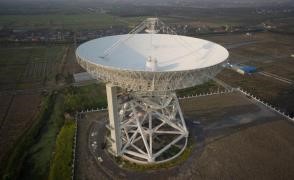 The Shanghai 65m Radio Telescope (“Tianma”) is a major joint project between the Chinese Academy of Sciences and the City of Shanghai. The general objective of the project is to build an omnidirectionally movable radio telescope with a 65m aperture, which is a leading facility in China, the largest in Asia, and with overall performance ranking in the fourth position internationally.
The Shanghai 65m Radio Telescope (“Tianma”) is a major joint project between the Chinese Academy of Sciences and the City of Shanghai. The general objective of the project is to build an omnidirectionally movable radio telescope with a 65m aperture, which is a leading facility in China, the largest in Asia, and with overall performance ranking in the fourth position internationally.
The Shanghai 65m Radio Telescope was approved at the end of October 2008. Its foundation was laid on December 29, 2009, its construction started on March 19, 2010, and took a total of four years to complete on October 28, 2012. The mission was accomplished very well in all the stages involving the antenna system, receiving system, active moving system, terminal system, station control and time/frequency system. Furthermore, construction of the test station and experimental astronomy observation were completed according to the project plan. Test results based on the “Shanghai 65m Radio Telescope System: Stage-One Acceptance Test Guidelines” indicated that all the technical performance indices specified by the project plan have been met or surpassed. Thus we have achieved our objective of building a large world-class radio telescope.
With a height of 70m and weighing about 2,700 tons, the Tianma is presently our country’s omnidirectionally movable, high-performance radio telescope that has the largest aperture and widest frequency range. Its operating wavelengths from 7 mm to 21 cm in eight sections cover the entire centimeter and long millimeter range for radio astronomical observation. The research and development contents of the first stage of the project include a 65m horizontal-mode radio telescope equipped with an adjustment system for the active reflecting surface, a dual-polarization cryogenic receiver in four wavelengths (L, S, X and C), a VLBI data recording terminal, a radio telescope observing terminal, and a hydrogen atomic clock associated with a time-frequency comparison subsystem. After the second stage of the project is completed in 2015, the radio telescope will be equipped with high-frequency observing systems including an active surface and Ku, K, Ka and Q-band receivers.
The Shanghai 65m Radio Telescope was selected as one of the 2012 Top Ten News of Science/Technology Development in China (“Completion of Asia’s No. 1 Radio Telescope”) by members of the Chinese Academy of Sciences and Chinese Academy of Engineering. It was voted as one of the 2012 Top Ten News of National Defense Science & Technology Industries by the National Defense Science and Engineering Department. It was the First Prize winner of the 2012 Shanghai Top Ten Progresses in Science & Technologies. It was also on the 2012 list of Top Ten Advances in Astronomy.
The Shanghai 65m Radio Telescope successfully accomplished the Chang’r-3 VLBI orbit determination mission in December 2013. Using the 65m instead of the 25m radio telescope resulted in an improvement of more than 2.6 times in the sensitivity of our country’s VLBI observing network, and a reduction of the VLBI time delay (ΔDOR mode) measurement errors for the lunar lander from 1.77ns rms (Chang’e-2) to 0.67 ns rms (Chang’e-3). The latter improvement has made an outstanding contribution to the orbit determination of Chang’e-3 with an accuracy of several centimeters in detecting the motion or turning actions of the lunar lander, and an accuracy of better than 1 m in relative positioning of the lander. Related results have been reported a number of times on the “Radio Science ”and “Science China” magazines.
In the area of pulsar research and observation, we have completed the task of installing and testing the digital terminal DIBAS. At present, the terminal has the function of removing both non-coherent and coherent chromatic dispersions; it can carry out on-line periodic superposition as well as pulsar observation in search mode. To assure standardization and flow management of pulsar observation, a set of modules for the standardization of observational guidelines were designed, and communication with the digital terminal and telescope control unit were completed, thus basically realizing observation automation. Utilizing the new system, we have successfully detected a batch of important pulsars in the northern sky with the shortest millisecond periods in the L, S, C and X bands. In particular, we have discovered a current research hotspot ¾ the possibility that the “Galactic-Center Magnetar” has glitches in its signal period. Our results will be disclosedto fellow scientists at home and abroad in the latter half of 2014.
For spectral line observation, we have basically realized automation of observation as well. Completion of the tasks of frequency calibration at the spectral line terminal and data format conversion enables users to carry out spectral line data processing with the Gildas software package which is generally used in spectral line processing. We have detected in the L, C and X bands numerous transitions of important molecules, including those (such as HC7N) with long carbon chains. We have also detected some new hydroxyl maser sources in L band.
The overall performance of the Tianma Radio Telescope ranks among the top ones in the world. It is also advantageously located at the intersection of several major VLBI networks. The telescope will substantially increase the detection sensitivity of international VLBI networks, and will become the core of the Chinese and East-Asian VLBI Networks. Hence it will notably raise China’s international position in the frontier research topics in astrophysics. The Tianma telescope has initially shown its sensitivity advantage through participation in trial joint observations with the G BT (U.S.), EVN and East-Asian VLBI Network. More detail inforamtion of the research plan will describe in session 3.3